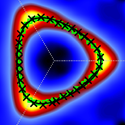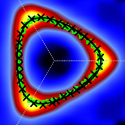Dirac cone revealed
Idealized graphene is a two-dimensional sheet of carbon. The electrons in graphene behave like massless Dirac particles that appear in the electronic band structure as gapless excitations with a linear dispersion—the “Dirac cone.” However, in real life, graphene is never perfectly flat and may interact with the substrate that supports it, which significantly alter graphene’s electronic properties. Invariably, these effects open a gap that limits the observation of relativistic physics in graphene.
In an article appearing in Physical Review B, Alexander Grüneis and colleagues at the IFW in Dresden, Germany, and collaborators from Austria and Spain observe the full Dirac cone dispersion, expected for isolated graphene, in an intercalated graphite compound using angle resolved photoemission spectroscopy. The crystal consists of individual graphene sheets separated by layers of potassium. It turns out that there is a complete charge transfer from potassium to the graphene layers but there is no Coulomb interaction between the layers. This preserves the Dirac cone dispersion for both the valence and conduction bands, though the doping shifts the Dirac point away from the chemical potential (differently from what is expected for pristine graphene).
Grüneis et al. also perform electronic structure calculations to find excellent agreement with experimental data as long as electron-electron interactions within the graphene sheets are taken into account. These results provide crucial input to study the electronic and transport properties of isolated graphene, which has hitherto been difficult due to substrate effects. – Sarma Kancharla





